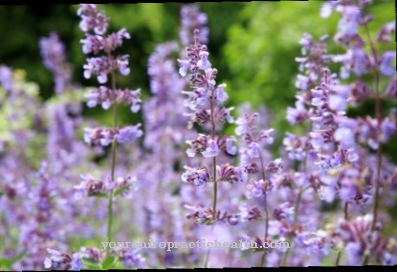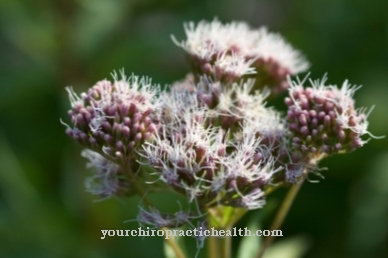In the Indian snake root it is a tried and tested medicinal plant from South Asia. In India it was used, among other things, to treat snakebites.
Occurrence & cultivation of the Indian snake root

The name Rauwolfia is due to the French botanist Charles Plumier (1646-1704), who honored the German botanist Leonhard Rauwolf (1535-1596) in this way. The name Serpentina is a reference to the snake-like shape of the plant.
The Indian snake root is one of the evergreen shrubs and grows upright. It has a smooth white rind and milky sap. The small flowers develop between April and May. The sepals are reddish in color, while the petals are white. In addition, the Indian snake root forms black drupes that reach a size of around 8 millimeters.
The place of origin of the Indian snake root is India. From there the plant spread to Pakistan, Sri Lanka and Indonesia. The Rauwolfia serpentina primarily thrives in the tropical regions of northeast India and in the Himalayan region. Other growing areas are Malaysia, Burma and Thailand. The harvest time takes place in late October to early November.
Effect & application
Medically usable active ingredients of the Indian snake root are the around 60 different alkaloids. These include primarily the monoterpene alkaloids of the yohimban, heteroyohimban, ajmalan and sarpagan type. The main active ingredients are rescinnamine and reserpine. Reserpine has a blood pressure lowering and calming effect. The alkaloids also include yohimbine, serpentine, ajmaline and deseripine.
The mixture of alkaloids has the property of having a mood-enhancing, antispasmodic and laxative effect. The Indian snake root is usually administered medically as a finished preparation. In higher doses, however, the Rauwolfia is considered poisonous. For this reason, use is only permitted according to a doctor's prescription. The Indian snake root is initially taken in small doses. These are administered until the appropriate dosage is reached. This is followed by long-term treatment with the preparation, which can last up to a year.
In homeopathy, the Indian snake root is used in the low potencies D1 to D4. The herbs are mainly used to treat depression and high blood pressure. Up to potency D3, the Rauwolfia is subject to prescription. In the D6 potency, it can be administered for the treatment of nervous disorders. The means are usually taken in the form of tablets or drops.
Combinations with reserpine are primarily used. The only single drug is Gilurytmal, which contains ajmaline. It is used to treat cardiac arrhythmias. Ayurvedic medicine also appreciates the Indian snake root. There it is classified as heating and dry. Despite its bitter taste, it has a pungent effect on digestion. Due to its calming effects, it is used against nervous restlessness and cramps.
Traditional Chinese Medicine (TCM) uses Indian snake root to treat liver problems, dizziness and high blood pressure associated with headaches.
Importance for health, treatment & prevention
The Indian snake root was already mentioned in Ayurvedic texts in the 7th century BC. Mentioned. In ancient India, healers mainly used them against snakebites. The exotic medicinal plant did not reach Europe until the early 18th century when it was discovered on research trips. On the European continent, too, the Rauwolfia was initially used as in Indian folk medicine.
In 1952, scientists were able to isolate the most important active ingredient in Indian snake root, reserpine, which enabled chemical production. In this way, the Rauwolfia could already be used on a broad basis by medicine two years later. The main area of application was psychiatric illnesses such as psychoses. The Indian snake root was one of the first drugs to be tested for the treatment of schizophrenia.
Through intensive research, scientists also gained important knowledge about the metabolism of the human brain, which in turn allowed new useful preparations to be developed. However, the reserpine had the disadvantage of numerous side effects. This ultimately led to a decline in reserpine use. In the 1970s, reserpine was replaced by preparations that were better tolerated.
For a long time, Rauwolfia was also considered an important treatment for high blood pressure. In 1986 the Indian snake root was rated positively by Commission E and recommended for the treatment of mild high blood pressure, psychomotor restlessness, tension and anxiety states if other measures had no effect. However, due to the strong side effects, the medicinal plant was rarely used.
The Rauwolfia was only used as reserpine in a low dose together with other high blood pressure drugs. The Indian snake root is a proven remedy in homeopathy today. There the preparation is administered in homeopathic dilution against mild heart pain and essential hypertension.
As already mentioned, various side effects are possible when taking Indian snake root, which can be attributed to the strong effects of the plant. These can be nightmares, depression, anxiety, heart problems, circulatory problems, Parkinson's symptoms and muscle weakness. Rauwolfia must not be used if the patient suffers from diseases such as depression, nephrosclerosis or hardening of the arteries of the cerebral vessels.








.jpg)



















